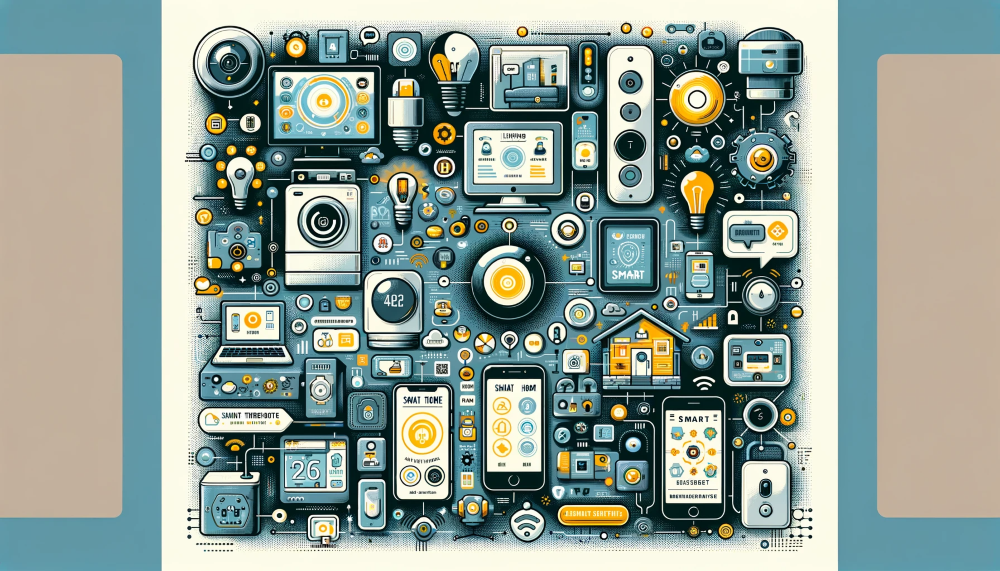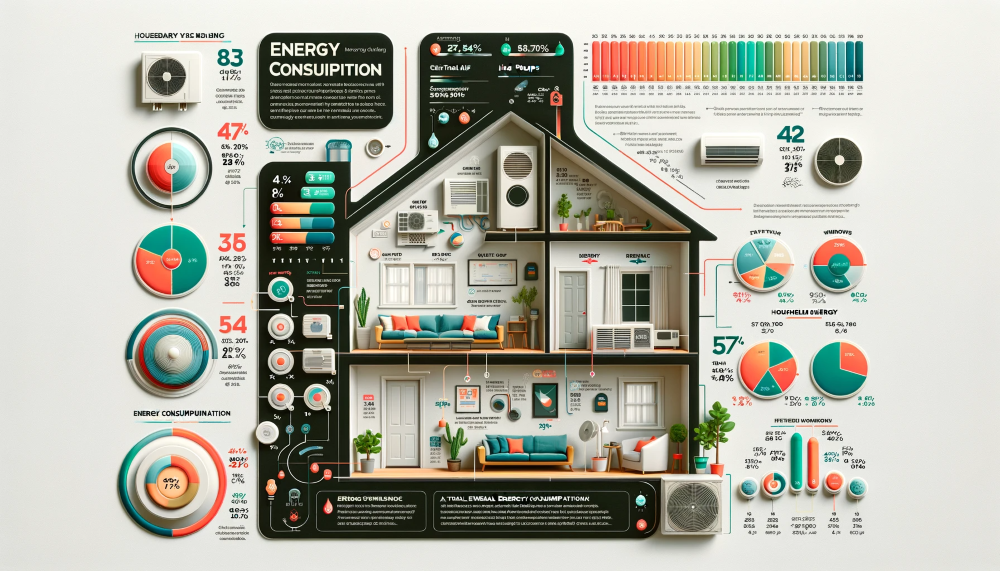HVAC Automation for Intelligent Homes
Enhancing Comfort and Efficiency
The concept of intelligent homes, defined by their ability to adapt and respond to the needs of the inhabitants, is revolutionizing the way we live. Central to these smart living spaces is the HVAC (Heating, Ventilation, and Air Conditioning) system, a critical component in maintaining a comfortable and healthy indoor environment. As home automation systems become increasingly sophisticated, the integration of smart technology into HVAC systems presents a significant opportunity for energy savings and enhanced living quality. This post delves into how HVAC automation is not just a luxury but a smart investment towards reducing energy consumption and improving indoor air quality in intelligent homes.
Understanding HVAC Systems in Intelligent Homes
HVAC systems are more than just equipment for heating and cooling. In the realm of intelligent homes, they are dynamic systems integrated with smart devices and technology to create an environment that adjusts to your preferences while optimizing energy usage. At the heart of this integration is HVAC automation, which leverages smart HVAC systems to streamline and control heating and cooling costs effectively. With the help of sensors and remote control capabilities, these systems can learn your habits and adjust the indoor climate accordingly, ensuring comfort without unnecessary energy expenditure. The result is a harmonious balance between maintaining optimal indoor air quality and reducing energy consumption, making them an essential component of modern, energy-efficient homes.
The Evolution of HVAC Automation
HVAC automation has come a long way from simple, programmable thermostats to advanced systems equipped with AI and smart technology. Initially focused on basic temperature control, the evolution has been marked by a shift towards comprehensive home automation systems that manage air conditioning, heating, and ventilation in a coordinated manner. Today's smart HVAC systems are not only about maintaining a desired temperature; they're about understanding and adapting to your lifestyle for maximum energy savings. They can detect when you're home or away, adjust settings for optimal energy usage, and even provide maintenance alerts. This evolution is driven by a growing demand for reduced energy consumption and a more proactive approach to heating and cooling costs, pushing the boundaries of what automated systems can achieve in intelligent homes.
Benefits of Automating Your HVAC System
Automating your HVAC system is a game-changer for homeowners seeking to enhance energy efficiency and reduce their energy bills. Integrating HVAC systems with smart technology, primarily through a smart thermostat, allows for precise control over your home's heating and cooling, leading to significant energy savings. One of the most immediate benefits is the ability to adjust your home's temperature from anywhere at any time. Whether you're at work or on vacation, you can ensure that you're not wasting energy heating or cooling an empty house. This level of control can lead to a drastic reduction in energy bills, as the system conserves power when full heating or cooling isn't needed.
Beyond just the convenience of remote control, smart thermostats learn your preferences and schedule, adjusting the environment to suit your daily routine. By understanding your habits, these systems ensure that you're using energy only when it's needed, contributing to reduced energy consumption overall. Moreover, many smart HVAC systems provide detailed reports on energy usage, offering insights into how you can further optimize your heating and cooling to save money.
The integration of HVAC automation isn't just about immediate savings on energy bills; it's also an investment in the longevity of your system. By operating only when necessary and maintaining optimal performance, automated systems reduce the wear and tear on your HVAC equipment, potentially extending its life and saving you money on costly repairs and replacements. In sum, the benefits of automating your HVAC system with a smart thermostat and other smart devices are clear: not only do you gain greater control and convenience, but you also contribute to a more sustainable future with significantly reduced energy consumption and lower energy bills.
Key Features of Automated HVAC Systems
At the core of any efficient smart HVAC system lies advanced technology designed to optimize energy consumption and enhance energy efficiency. Key features of these systems are centered around the smart thermostat, a pivotal component that goes beyond mere temperature adjustment to truly save energy. A smart thermostat is the brain of the smart HVAC system, learning from your habits and preferences to create an environment that's comfortable yet energy-efficient.
Customized Comfort
One of the primary features of a smart thermostat is its ability to be programmed to suit your lifestyle. It can adjust the heating and cooling based on when you’re usually home, asleep, or away, ensuring that you're not wasting energy on an empty house. Some advanced models can even detect your presence and adjust settings accordingly, providing comfort when needed and saving energy when you're away.
Substantial Cost Savings
Another key aspect of optimizing energy consumption is through zoning. Many smart HVAC systems allow for the creation of zones in your home, meaning you can heat or cool specific areas as needed, rather than expending energy on unused spaces. This not only contributes to energy savings but also enhances overall comfort as each area can be customized to individual preferences.
Additionally, many smart HVAC systems are equipped with sensors that monitor not just temperature, but also humidity and air quality. These components work together to maintain an optimal indoor environment, adjusting the system's operations based on real-time data. This means the system doesn't just work harder when it's hot or cold outside but also understands when to humidify or purify the air, ensuring a healthy and comfortable home environment.
Smart HVAC systems often come with companion apps, providing you with detailed insights into your energy usage and system performance. These apps can show you how much energy you're using, suggest ways to save energy, and even alert you to potential issues with your system before they become serious problems.
In summary, the advanced technology and features of smart HVAC systems, centered around the smart thermostat, are transforming how we manage our home environments. By optimizing energy consumption and providing unparalleled control and insight, these systems are not just about comfort — they're about strategically managing energy use to save energy, reduce costs, and create a more sustainable living space.
Implementing HVAC Automation in Your Home
Embracing energy efficiency and creating a comfortable living environment begins with implementing HVAC automation in your home. Integrating your HVAC system components with a smart thermostat and other smart devices is the first step towards efficient climate control that can be managed and controlled remotely. Here’s how you can begin this transformation:
Assess Your Current System: Before upgrading, understand the capabilities and limitations of your current heating, cooling, and air conditioning systems. Determine if they can be integrated with smart devices or if you'll need to invest in new, compatible equipment.
Choose the Right Smart Thermostat: Select a smart thermostat that fits your specific needs and budget. Look for features like learning capabilities, remote access, energy usage reports, and compatibility with other smart home devices. Ensure that it can effectively communicate with all the components of your HVAC system to provide seamless, efficient climate control.
Expand with Additional Smart Devices: Consider other smart devices that can enhance your HVAC automation. Smart vents can regulate airflow to different rooms, and air quality sensors can monitor and adjust the air composition in your home. These devices work in tandem with your smart thermostat to provide a comprehensive solution for a comfortable living environment.
Professional Installation: While some homeowners may be comfortable installing a smart thermostat on their own, professional installation is recommended to ensure that all components of your HVAC system are correctly integrated. A professional can also provide valuable advice on how to optimize your system for maximum energy efficiency.
Set Up and Customize: Once installed, take the time to customize the settings of your smart thermostat and devices. Set schedules that reflect your routine, define zones if applicable, and set your preferences for temperature and air quality. The more accurately you define these settings, the more your system can learn and adjust to your lifestyle, leading to greater energy savings.
Monitor and Adjust: After implementation, monitor your system and energy usage. Many smart thermostats provide detailed reports and insights into your energy consumption. Use this data to make informed adjustments, fine-tuning your settings to balance comfort and energy efficiency.
By carefully selecting and integrating the right smart thermostat and HVAC system components, and ensuring everything is set up for optimal performance, you can transform your home into a hub of energy efficiency. Your automated system will not only contribute to a more comfortable living environment but also enable you to control your climate remotely, ensuring that your home is always welcoming while you save on energy costs.
Overcoming Challenges in HVAC Automation
While the transition to a smart home system equipped with HVAC automation promises significant energy savings and a more comfortable living environment, homeowners may encounter several challenges along the way. Understanding these obstacles and knowing how to address them is crucial for a smooth transition and to minimize energy waste. Here are some common challenges and strategies to overcome them:
1. Ensuring Reliable Internet Connection: A robust internet connection is the backbone of smart home technology. Your smart HVAC system, including the smart thermostat and other related devices, relies on this connection to function correctly and communicate with each other. To prevent disconnections or lag, ensure your home network is reliable and strong enough to support your smart home devices. Consider upgrading your router or adding network extenders if you experience connectivity issues.
2. Compatibility with Existing Systems: Not all HVAC systems are compatible with all smart thermostats or devices. Before investing in smart home technology, verify that the new devices will work with your existing HVAC components. If compatibility issues arise, you might need to consider additional upgrades or seek out specific smart devices designed to work with your current system.
3. Technical Knowledge and Comfort: Transitioning to a smart home system can be daunting, especially for those who are not tech-savvy. The installation and operation of smart devices might require a level of technical knowledge that not all homeowners possess. To overcome this, seek professional installation and ask for a detailed tutorial on managing your new system. Many manufacturers also offer customer support and resources to help you get comfortable with your new technology.
4. Initial Costs: While smart home technology can lead to significant energy savings over time, the initial investment might be a barrier for some. The cost of smart thermostats, additional sensors, and professional installation can add up. To mitigate this, consider the long-term savings on your energy bills, and check for any available rebates or incentives offered by manufacturers, utility companies, or government programs.
5. Adapting to a New Lifestyle: Integrating smart technology into your home changes how you interact with your living environment. It requires a shift in habits and routines, especially as you learn to trust your system's automation features. Be patient and allow yourself time to adjust. As you become more comfortable with the technology, you'll start to recognize the benefits of reduced energy waste and enhanced comfort.
By anticipating these challenges and preparing to address them, homeowners can ensure a smoother transition to a smart home system. The key is to do thorough research, seek professional advice, and embrace the learning curve. With the right approach, the benefits of HVAC automation in smart homes will undoubtedly outweigh the initial hurdles.
The Future of HVAC Automation in Intelligent Homes
The future of HVAC automation is poised to offer even greater energy efficiency and smarter home integration. As technology continues to advance, we can expect to see a new generation of smart devices and systems designed to make our homes more comfortable, efficient, and environmentally friendly. Here's what the future might hold:
Advanced Smart Sensors: Future smart sensors will go beyond simple temperature measurements. They will detect occupancy, humidity, and even air quality with greater accuracy. This means your HVAC system will not only know when to adjust the temperature for comfort but also when to bring in fresh air to maintain a healthy indoor environment.
Machine Learning and AI: Smart home systems will increasingly use AI and machine learning to learn from your habits and preferences. This technology will predict your needs and make adjustments before you even realize you want them, ensuring optimal comfort and improved energy efficiency without any extra effort on your part.
Integration with Renewable Energy: As homes become more connected to renewable energy sources, HVAC systems will intelligently integrate with these systems. They'll be able to use solar or wind power when available to operate even more efficiently and reduce reliance on non-renewable energy sources.
Self-Diagnosing and Repair Notifications: Future HVAC systems will be able to diagnose issues and alert you before they become serious problems. They might even be able to schedule maintenance visits automatically, ensuring they're always running at peak efficiency.
Conclusion
HVAC automation is transforming our homes, offering not just improved energy efficiency but also a level of comfort and convenience that was unimaginable a few years ago. By integrating smart devices, smart sensors, and a comprehensive home automation system, homeowners can enjoy greater energy efficiency and a more responsive living environment. As technology continues to advance, the potential for even more savings and comfort is on the horizon. Whether you're looking to save on energy bills, reduce your environmental footprint, or simply enjoy the convenience of a modern, intelligent home, HVAC automation is a smart investment that pays dividends in comfort, convenience, and cost savings.
FAQs
How much can I really save with an HVAC automation system?
Savings can vary based on your current system, how you use it, and the type of smart devices you install. However, many users report noticeable reductions in their energy bills due to more efficient heating, cooling, and the ability to control systems remotely.
Is it worth upgrading my old HVAC system to a smart one?
In most cases, yes. Older systems tend to be less efficient and might not offer the same level of control and convenience as newer models. Upgrading can help you save on energy costs and enjoy a more comfortable and convenient home environment.
Can I integrate HVAC automation with other smart home systems?
Absolutely. HVAC automation is just one part of a broader smart home system. Many smart thermostats and devices can integrate with lighting, security, and other systems to create a fully connected home.
By embracing HVAC automation, you're taking a significant step towards a more efficient, comfortable, and intelligent home. As the technology continues to evolve, the benefits will only grow, making now the perfect time to consider upgrading your system.





